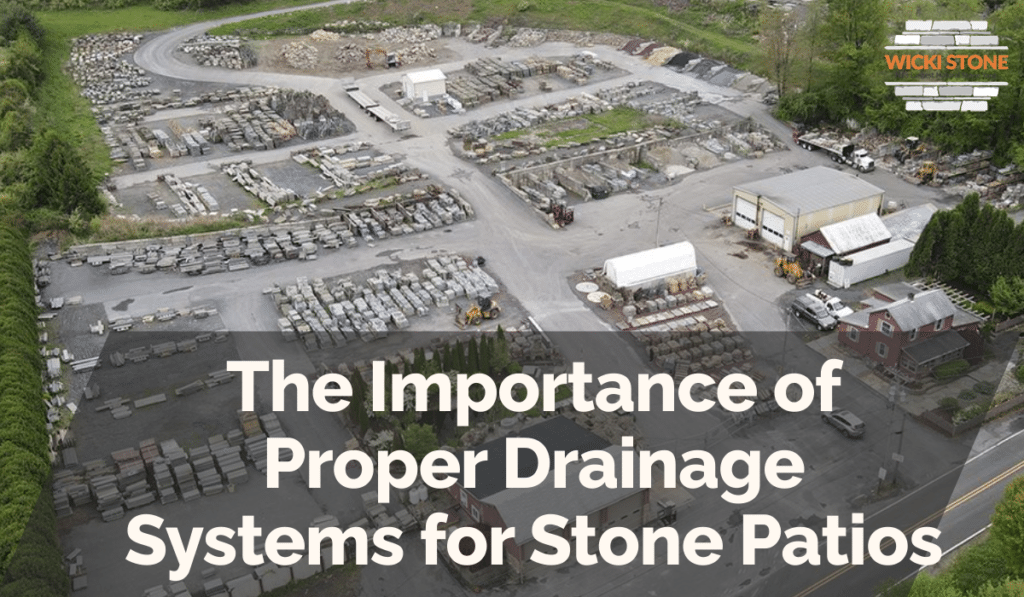
The Importance of Proper Drainage Systems for Stone Patios
A well-designed outdoor space not only enchants with natural beauty but also functions seamlessly, especially when natural stone is involved. A proper drainage system is essential to maintain the longevity and cleanliness of a stone patio. Without it, water pooling or seepage can lead to erosion, staining, and unpleasant slippery surfaces.
Understanding the Role of Drainage
Water is both an artist and a destroyer. While a gentle rainfall can refresh a patio, stagnant water can wreak havoc over the years. Proper drainage systems are designed to guide rainwater away from the stone surface, protecting the natural stone and underlying structure. This ensures that the formation of puddles is minimized, preventing water from pooling and causing damage to both the appearance and stability of the patio.
How Drainage Protects Natural Stone
Natural stone is porous, which means it readily absorbs water. Water retention in the stone surfaces can lead to several problems, including:
- Moisture trapping, which may cause efflorescence and staining.
- Freeze-thaw cycles, which can lead to cracks and surface deterioration.
- Weakened structural integrity due to prolonged water exposure in underlying layers.
By providing a channel for water to escape, a proper drainage system helps in preserving the stone’s natural texture and color while keeping the patio surface safe for everyday use.
Components of an Effective Drainage System
An efficient drainage system is a blend of strategic planning and quality materials. Key components include:
- Surface Slope: A slight gradient ensures water runs off the patio instead of lingering. Even a minimally sloped surface can make a significant difference.
- Gravel Layers: Beneath the stone, gravel or crushed rock layers facilitate effective water flow and prevent waterlogging.
- Drainage Channels or Trench Drains: These specialized channels capture and redirect water away from the area, often connecting to a larger drainage system or garden feature.
- Geotextile Fabrics: These fabrics help prevent the mixing of soil with gravel, ensuring that the drainage paths remain functional over time.
Planning and Installation Considerations
Before installing a stone patio, it’s crucial to evaluate the site’s natural water flow and consider potential challenges. Here are some steps to guide the planning process:
- Assess the natural slope of the land to determine the best path for water evacuation.
- Consult with local contractors who have experience working with natural stone to avoid common pitfalls.
- Ensure that local building codes and environmental guidelines are followed.
- Consider the overall landscape design so that the drainage system complements other outdoor features.
Regular Maintenance Practices
Even the most expertly designed drainage system requires periodic inspection and maintenance to remain effective. Regular maintenance can include:
- Cleaning debris from drainage channels to avoid blockages.
- Checking the slope and ensuring that settling terrain hasn’t led to uneven surfaces.
- Inspecting the natural stone for early signs of water damage.
Seasonal inspections, particularly following heavy rainfall or snowmelt, contribute to the long-term durability of the patio structure.
Frequently Asked Questions
Why is proper drainage important for stone patios?
Proper drainage prevents water accumulation and seepage, which can cause surface erosion, staining, and structural damage to the natural stone and its base layers.
What are the common signs of drainage problems on stone patios?
Indicators of drainage issues include water pooling, slippery surfaces, cracking or spalling of the stone, and visible erosion or staining on the surface.
Can I install a drainage system on an existing stone patio?
Yes, it is possible. Retrofitting a drainage solution might involve lifting some of the natural stone, installing a proper substrate, and then replacing the stone. Professional evaluation is recommended to determine the best approach.
How does climate influence the need for drainage systems?
Regions with heavy rainfall or those experiencing frequent freeze-thaw cycles require robust drainage systems to mitigate water-related damage. Proper drainage protects the stone by reducing water retention and preventing ice formation on the surface.
Conclusion
Maintaining the beauty and functionality of a stone patio is not just about aesthetic appeal—it requires a careful approach to water management. A thoughtfully designed drainage system is the backbone of any durable stone patio, ensuring that water is efficiently managed and natural stone retains its pristine appearance. With the right planning, installation, and maintenance, homeowners can enjoy the enduring charm of their outdoor space while safeguarding against water damage for years to come.
